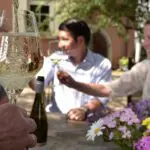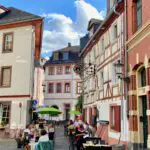There are ghosts lingering in my culinary world. The ghosts of the stuff tasted sometimes ago (yes, we had given them a chance) and shelved for life. There is the ghost of Brussel sprouts for instance. Or the ghost of Sylvaner.
Once sufficient bloggers conjure them, these ghosts creep out… haunting and probing until confronted. With top German journalists sining the praise of Sylvaner, especially at the recent VDP Grand Cru 2020 tasting in Wiesbaden, I had to face my ghost.
You are forgiven if you haven’t heard of Sylvaner, as the wines rarely make it out of Germany and New World winemakers have shown no interest whatsoever. Though if you care about German wines, you may have noted the particular shape of its very own bottle, the Bocksbeutel. The Bocksbeutel is as iconic as the Riesling Flute, but its plump, unpractical shape doesn’t necessarily contribute to its popularity outside its core regions.

Speaking of core regions: good expressions of Sylvaner come from the wine region of Rheinhessen, but Franconia (map* at the bottom of this page) is where Sylvaner is really thriving. Sylvaner vines initially came from Austria, the first vineyard being planted in 1659 at a Franconian domain called Castell (now managed in the 30th generation).


Since then it has been a bit of a bumpy ride for Silvaner: Its ability to produce a sound crop and its short fruit maturation period (budding later and ripening earlier than Riesling) boosted its popularity in Germany. Making for 30% of all vineyards in its heydays, it was the leading white wine varietal for a while – but then unambitious winemaking resulted in wines of little organoleptic contribution – the wines were rather boring. When at the turn of the millennial Germany’s winemakers pushed for more quality wine production, Sylvaner had to yield to Riesling.
But keen vintners are increasingly exploring its virtues: Similar to Riesling it can be a most terroir-ish varietal, at its best an expression of the soil and microclimate it has been grown in. Growing on 5000 hectares today, Sylvaner is at about 5% of Germany’s total vineyard area. Also, similar to Riesling, it can cover the full range of styles, all the way from bone-dry to noble sweet. There are even Sylvaner Sekts. And Sylvaner can mature nicely, though in the past only few winemakers produced wines with maturation potential in mind.

In the entry range Sylvaner carry light fruit, very often pear aromas, hay and straw. It works very well as Orange wine, a long maceration on the skin adding richness. Complex Sylvaners can sport apple, tropical fruit, nuts, sherry, and wood aromas. Acidity in Sylvaner is less forward than in Riesling.


I did shed my last Silvaner inhibitions when taking a trip through Franconia: visiting the vineyards along the river Main, taking a peek into the historic cellars of the Julius Spital (yes: a winery AND hospital in one), and strolling the medieval village of Iphofen. A region that pretty and that saturated with historic villages can’t possibly be the source of bad wines!
I did shed my last Silvaner inhibitions when taking a trip through Franconia: visiting the vineyards along the river Main, taking a peek into the historic cellars of the Julius Spital (yes: a winery AND hospital in one), and strolling the medieval village of Iphofen. A region that pretty and that saturated with historic villages can’t possibly be the source of bad wines!
Some of the great Franconian winemakers to look out for are: Bürgerspital, Julius Spital, Weingut Sauer, Weingut Bickel-Stumpf, Weingut Rudolf May, Weingut Hans Wirsching, Zehnthof Luckert.

My Silvaner ghost turned out to be a very nice one.
Now to you, Brussel sprouts!








